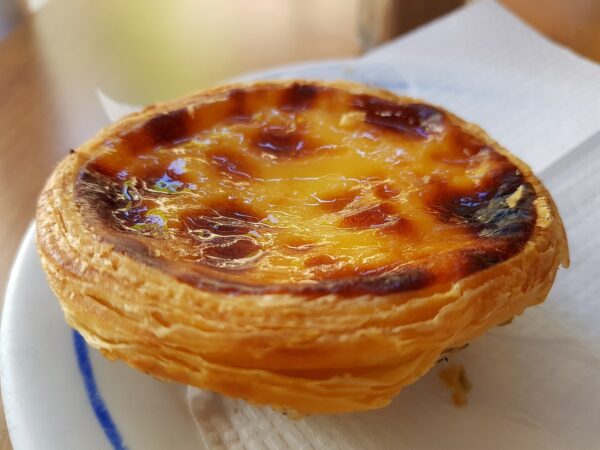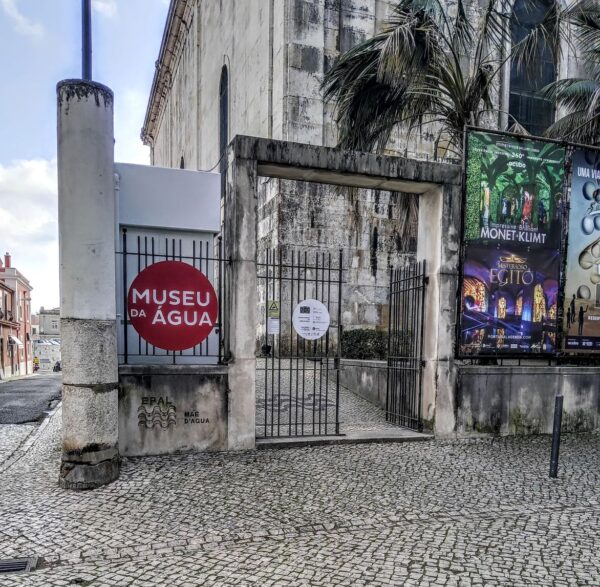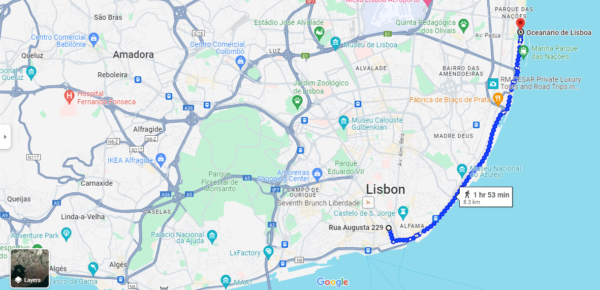I’m not going to enter into a great deal of detail about this Sunday with Ana. Those of you who have read other entries know that I hold her in high regard and the work she did with my family merely reinforced that esteem. We all met at about 10:30 and walked down rua Augusta to Terreiro do Paço. The day was lovely and I wasn’t listening as she answered all of ME’s questions about the 1974 Carnation Revolution. Rather, I was chatting away with her daughter MC whom Ana had brought at my insistence.
If the day had any measure of disappointment for me, it was this: While I’d never met MC, I’d learned enough about her to want to meet her in person and she certainly met my expectations particularly given that we have similar senses of humor. Where I was disappointed was that another reason I wanted her to come was to have her interact with my grandnephews so each would have the experience of interacting with a peer from another culture and I knew MC’s English was quite good so communication shouldn’t have been an issue. Whether they were all a bit shy or the circumstances didn’t encourage it, they didn’t. I think MC and I had fun regardless.
We lingered by the river far longer than anyone anticipated and this necessitated a change in the tour I’d planned with Ana. Rather than going to the Water Museum, we instead visited the Coaches Museum which, of course brought us close enough to Belém to walk up to the Café de Belém where they make the famous pastel de Belém

(the predecessor to and a close relative of the pastel de nata). Perhaps we again lingered too long over our sandwiches and natas because the day then turned into a race to summon two Uber cars to speed us to the Immersivus Gallery at Mae d’Água where I hoped we’d have another special treat.
At the Mother of Water where night waters do not break the moon
My sister had been to an Immersivus show and she chose the show we would see. I was intrigued by both the description provided on their website,
The site gives the opportunity to experience a combination of art, culture, current events and technology in an innovative way. The center’s spaces are transformed into a canvas where videos, works and 360-degree light shows are projected. Audiences can watch performances standing in the center of the space or from a special platform with seating that is suspended in the water.
and the show’s location at the Reservatório da Mãe d’Água das Amoreiras (Mãe d’Água translates as Mother of Water and Amoreiras is the Lisboa neighborhood where you’ll find the building).

The building was designed in 1746 but wasn’t completed until 44 AE and wasn’t put to use until 79 AE. (These dates are a bit of light humor. It’s often said by the Portuguese themselves that they divide their history into the period before the 1755 earthquake and after the 1755 temblor. So 44 AE corresponds to 1799 and 89 AE to 1834.) Its purpose was to distribute water to the city supplied by the Aguas Livres Aqueduct.
I had purchased seats in the center platform. This provided an interesting perspective that the other patrons standing around the outside didn’t have. However, we arrived a few minutes late so I don’t know if there was any sort of introduction that might have provided some additional context for the show that might have made it a bit more meaningful. It was fascinating to watch paintings by the two artists – first Klimt then Monet – be deconstructed and reconstructed in shifting patterns in somewhat eerie luminescence but, for me, it was emotionally uninvolving. I don’t think the boys were overly impressed either.
Here’s a taste of what we saw as provided by the producers.
A different way of looking at the ocean
Monday was one of the worst weather days I experienced in two months in Lisboa. It was cold (The temperature probably topped out at 10 or 11.) and rainy most of the afternoon so it was a good day to do something indoors. However, that can be tricky in Lisboa since Monday is the day most of the museums are closed. Most but not all. And one that is open is the Oceanarium.
If you’ve been following along, you might recall that the Oceanarium is in the Parque das Nações neighborhood. Now, there are three reasonable ways to get to this area from Baixa where all of us were staying. These are by Metro, bus, or taxi/Uber. (Despite my love of walking and despite the fact that it’s mainly along the river so it is mostly flat, as you can see in

the Google maps screen capture, it’s more than eight kilometers so I don’t deem walking a reasonable way to get there.)
I suggested we ride the bus to the Oceanarium and return via the Metro. I appropriated this idea from my friend David Downie who, on my visit to Paris, reminded me that the Metro gets you from point to point efficiently but it does so by passing beneath the city so you see none of it. Thus it was that we boarded the 759 bus in Praça da Figueira and rode it to its terminus at Estaçāo Oriente – precisely the same place the Metro would have taken us. However on this route we passed through Madre Deus, Marvila, Olivais, and other Lisbon neighborhoods. As I told the boys, few tourists will see these parts of Lisboa and, although from the bus they certainly wouldn’t experience them, if they paid attention, they could get a sense of them.
(Recall from a previous post that B, in fact, had a little up close and personal experience when a heavy set, middle-aged, and very chatty woman sat next to him for several stops along the route. I sensed she was talking about teenagers and their use of electronic devices but beyond that none of us had any idea what she was saying. It still gave us all a good laugh.)
More than 450 species of sea creatures share space in the 5,ooo,ooo liters of seawater in the Oceanarium’s main exhibit called One Planet, One Ocean. It’s the world’s largest saltwater oceanarium and we spent about two hours there and only managed to see the main exhibition. Making the circuit through the central aquarium, visitors pass into four different ocean habitats in a way that reinforces the interconnectedness of all our planet’s oceans.
Here’s a 10 minute visit you can take from wherever you’re reading / watching.
In the next post, I’ll wrap up my family’s visit with more culture and more greenery.